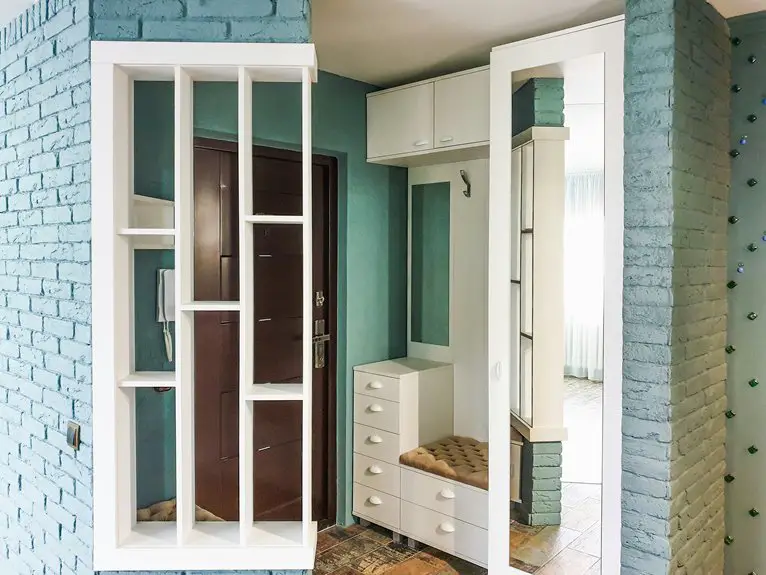If you’ve got chewing gum stuck to a velvet cushion, don’t panic! First, check the fabric type and colorfastness. You can try the freezing method by applying ice for 10-15 minutes, then scrape it off gently. Alternatively, use a hairdryer on low heat to soften the gum before removing it. Afterward, clean any residue with white vinegar or soap. To keep gum off your cushions in the future, preventive measures can help maintain their beauty and integrity.
Table of Contents
Key Takeaways
- Use the freezing method by applying ice to harden the gum for easier removal with a dull knife or scraper.
- Alternatively, apply low heat from a hairdryer to soften the gum before gently scraping it away.
- Clean any residue with white vinegar on a cloth or mix dish soap with warm water for gentle scrubbing.
- Regularly maintain velvet cushions by brushing and using fabric protectors to prevent future gum incidents.
- Educate household members about proper gum disposal and establish rules to minimize gum usage in common areas.
Assessing the Situation: Fabric Type and Colorfastness
When you find chewing gum stuck to your favorite fabric, how can you determine the best way to tackle it?
First, you need to assess the fabric type. Is it velvet, cotton, or synthetic? Each material reacts differently to treatments.
Next, check for colorfastness. Test an inconspicuous area with a bit of water or a mild detergent to see if the dye bleeds. If it does, you’ll need to be extra cautious to avoid damaging the fabric.
Identify if the gum’s texture is sticky or hardened, as this will influence your approach.
Safety Precautions Before Treatment
Before you treat any fabric, you need to assess its type and colorfastness.
Always test your removal products on a small, inconspicuous area first to avoid damage.
Finally, prepare your work area to guarantee a safe and efficient process.
Assess Fabric Type
Evaluating the fabric type is essential for effective gum removal. Different materials react differently to treatment methods, so you need to identify what you’re dealing with.
Here’s how to assess the fabric:
- Check the Label: Look for care instructions that indicate the fabric type. This can guide your approach.
- Conduct a Burn Test: If safe, take a small, inconspicuous thread and burn it. The way it burns can help identify synthetic versus natural fibers.
- Feel the Texture: Gently rub the fabric between your fingers. Velvet, for example, has a distinct, soft texture that requires special care.
Test Removal Products
Though you’re enthusiastic to tackle that gum stain, it’s crucial to test any removal products first to guarantee they’re safe for your fabric. Start by applying a small amount of the product to an inconspicuous area. Wait a few minutes to see if there’s any discoloration or damage.
Here’s a quick reference table to help you decide on testing:
| Product Type | Testing Method |
|---|---|
| Rubbing Alcohol | Apply with a cotton swab |
| Dish Soap | Mix with water, dab lightly |
| Vinegar | Test on a hidden spot |
Prepare Work Area
Once you’ve tested your removal products, it’s time to focus on preparing your work area. A clean, organized space makes the removal process smoother and safer. Here are three essential steps to follow:
- Clear the Area: Remove any items near the velvet cushion that could get damaged or dirty during the process. This keeps your workspace tidy and prevents accidents.
- Protect Surfaces: Lay down a drop cloth or old towel under the cushion. This will catch any drips or residue from your removal products, protecting your flooring.
- Gather Supplies: Have all your tools and products within reach. This guarantees you won’t waste time searching for items when you need them most.
With everything in place, you’re ready to tackle that gum!
The Freezing Method: Step-by-Step Guide
To tackle chewing gum stuck to your belongings, you’ll want to use the freezing method effectively.
Start by applying ice to harden the gum, then carefully scrape it away without damaging the fabric.
Let’s look at the techniques to guarantee you get it right.
Ice Application Technique
When you find yourself with chewing gum stuck to your clothing or carpet, the ice application technique can be your best ally. This method freezes the gum, making it easier to remove.
Follow these steps for effective results:
- Gather Ice: Grab some ice cubes or a freezer pack. Place it in a plastic bag to avoid moisture damage.
- Apply to Gum: Press the ice pack against the gum for about 10-15 minutes. You want it to harden completely.
- Check the Gum: After freezing, gently test if the gum has hardened. If it has, you’re ready to proceed with the next steps for removal.
This freezing technique can save your fabric without causing damage!
Gum Scraping Procedure
After freezing the gum, it’s time to tackle the removal process with a gum scraping procedure.
First, grab a dull knife or a plastic scraper—something that won’t damage your cushion. Carefully slide the edge under the frozen gum, applying gentle pressure. You want to lift it, not push it deeper into the fabric. Work slowly, moving from the outer edges toward the center.
If you encounter resistance, pause and freeze the gum again as needed. Once you’ve removed most of it, use a cloth dampened with warm water to wipe the area. This helps eliminate any sticky residue left behind.
Finally, let the cushion air dry, and you’ll be back to enjoying your velvet seat in no time!
Avoiding Fabric Damage
Removing gum without damaging your fabric requires careful handling during the freezing method. Follow these steps to guarantee a successful removal:
- Prepare the Ice: Grab a plastic bag and fill it with ice cubes. Seal it tightly to avoid leaks.
- Apply the Ice: Place the bag directly on the gum for about 15-20 minutes. This will harden the gum, making it easier to remove without harming the fabric.
- Gently Scrape: Once the gum is frozen, use a dull knife or spoon to gently lift it away from the fabric. Be cautious to avoid pulling on the material.
The Heat Method: Effective Techniques
If you’ve ever found yourself with gum stuck to your clothes or carpet, the heat method can be a game-changer for removal. You’ll need a few simple tools: a hairdryer and a cloth.
Start by setting your hairdryer to a low heat setting. Hold it about six inches away from the gum, moving it in a circular motion. This helps to warm the gum without damaging the fabric.
Once the gum softens, gently scrape it away with the cloth or a plastic spatula. Be careful not to apply too much pressure, as this can harm the fibers.
Repeat the process if necessary until the gum lifts away completely. This method’s effective and typically doesn’t cause any lasting damage to your fabric.
Removing Residue: Cleaning Solutions
Once you’ve successfully removed the bulk of the gum, you’ll likely notice some sticky residue left behind.
Don’t worry; you can tackle that too! Here are three effective cleaning solutions:
No need to stress; you can easily eliminate that residue with these three effective cleaning solutions!
- Vinegar: Dampen a cloth with white vinegar and gently rub the residue. The acidity helps break down the stickiness.
- Rubbing Alcohol: Apply some rubbing alcohol to a cotton ball and dab it on the residue. This method is great for dissolving adhesive substances.
- Dish Soap: Mix a few drops of dish soap with warm water. Use a sponge to gently scrub the area, rinsing with a clean cloth afterward.
Choose one of these methods to restore your velvet cushion’s beauty and say goodbye to that pesky residue!
Using Commercial Cleaning Products Safely
When you decide to use commercial cleaning products, it’s crucial to follow safety guidelines to protect yourself and your belongings.
Start by reading the label carefully; it contains essential information about usage and precautions. Always wear gloves and, if necessary, a mask to avoid skin irritation and inhalation of fumes.
Test the product on a small, inconspicuous area of the velvet cushion first to verify it won’t cause discoloration or damage.
Ventilate the area by opening windows or turning on fans to reduce the concentration of fumes.
Don’t mix different cleaning products, as this can create dangerous reactions.
Finally, store all cleaning supplies out of reach of children and pets to prevent accidental ingestion or exposure.
Stay safe while restoring your velvet cushion!
Final Care for Velvet Cushions
After ensuring your velvet cushions are clean and free from any harmful residues from commercial cleaning products, it’s time to focus on their final care.
To keep your cushions looking luxurious and vibrant, follow these simple steps:
- Brush Regularly: Use a soft-bristle brush to gently lift the pile. This helps maintain the fabric’s texture and prevents flattening.
- Spot Clean: For minor stains, use a damp cloth and mild soap. Blot gently, avoiding excessive moisture that can damage the fabric.
- Protect: Apply a fabric protector specifically designed for velvet. This adds a barrier against spills and dirt, keeping your cushions looking pristine.
Prevention Strategies for Future Incidents
To prevent future incidents with your velvet cushions, it’s essential to establish a proactive care routine.
Start by placing your cushions in low-traffic areas to minimize exposure to potential gum chewers. Consider using protective covers that can be easily removed and washed.
Regularly inspect your cushions for any signs of wear or damage, addressing issues before they escalate.
When entertaining guests, set clear guidelines about food and chewing gum in your living space. You might also designate a specific area for snacks to keep gum and other messes away from your cushions.
Finally, maintain a clean environment by vacuuming frequently to eliminate crumbs that could attract gum.
These strategies will help you preserve the beauty of your velvet cushions.
Educating Household Members on Gum Prevention
While it might seem like a small issue, educating your household members about gum prevention can make a significant difference in protecting your velvet cushions.
Here are three effective strategies to contemplate:
- Establish Clear Rules: Set household guidelines regarding gum chewing in common areas. Make sure everyone understands where it’s acceptable to chew gum.
- Provide Alternatives: Offer sugar-free mints or other snacks as substitutes for gum. This can help reduce the urge to chew gum, especially in shared spaces.
- Encourage Awareness: Remind everyone to be mindful of their actions. A simple reminder to dispose of gum properly can go a long way in preventing sticky situations.
Frequently Asked Questions
Can I Use Ice Directly on the Velvet Fabric?
You shouldn’t apply ice directly on velvet. The cold may damage the fabric, leading to water stains or changes in texture. Instead, consider using a gentler method to address the issue without harming your cushion.
How Long Should I Wait Before Attempting to Scrape off Gum?
Did you know that about 95% of people chew gum at least occasionally? Wait about five to ten minutes after applying ice before attempting to scrape off the gum. This guarantees it hardens properly for easier removal.
What if the Gum Leaves a Stain After Removal?
If the gum leaves a stain after removal, don’t panic. You can gently blot the area with a cloth and use a fabric cleaner, but always test it on an inconspicuous spot first.
Is It Safe to Machine Wash Velvet Cushions After Treatment?
You shouldn’t machine wash velvet cushions, as it can damage the fabric. Instead, opt for spot cleaning or professional cleaning services to preserve their texture and appearance while ensuring they stay fresh and clean.
Can I Use Vinegar on All Types of Velvet Fabrics?
You can use vinegar on some velvet fabrics, but it’s best to test a small area first. Not all velvets react the same way, so caution’s key to avoid damaging your fabric.
- The Story of Ikat in Mexico and Latin America - June 28, 2025
- How to Create a Bohemian Look With Ikat Textiles - June 28, 2025
- A Guide to Harlequin’s Modern Ikat Fabric Designs - June 28, 2025






